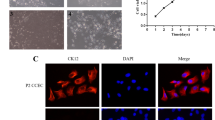Abstract
Purpose
To establish human corneal stroma- and sclera-derived cells as models for studying diseases of the anterior segment of the eye.
Methods
Using a recombinant retrovirus system, we transfected human papilloma virus 16 E6 and E7 (HPV16 E6/E7) into human corneal stroma- and sclera-derived cells. The primary cells and established cell strains were characterized by assessing the mRNA expression of collagen, matrix metalloproteinase, and tissue inhibitor of metalloproteinase by reverse transcription-polymerase chain reaction. We also examined the effects of inflammatory cytokines on hyaluronan synthase expression and hyaluronan products.
Results
Both a corneal stroma-derived cell strain, Cs3, and a sclera-derived cell strain, Sc1, were obtained, and both cell strains could be passaged up to 25 times. The mRNA expression pattern observed in the primary cells was identical to that observed in the cell strains. Hyaluronan synthase 1 and 2 mRNAs were increased by transforming growth factor β and platelet-derived growth factor BB. Significant differences were observed between the hyaluronan products with and without cytokine treatment.
Conclusion
Cell strains derived from corneal stroma and sclera fibroblast cells can be established using HPV16 E6/E7 immortalized genes of the same origin. The phenotypic cell characteristics did not change after transfection, immortalization, or successive passages in culture.
Similar content being viewed by others
References
Bron AJ, Tripathi R, Tripathi B. Wolff’s Anatomy of the eye and orbit, eighth edition. London: Chapman & Hall Medicine; 1997.
Nishitsuka K, Kashiwagi Y, Tojo N, et al. Hyaluronan production regulation from porcine hyalocyte cell line by cytokines. Exp Eye Res 2007;85:539–545.
Halbert CL, Demers GW, Galloway DA. The E7 gene of human papillomavirus type 16 is sufficient for immortalization of human epithelial cells. J Virol 1991;65:473–478.
Ihanamäki T, Pelliniemi LJ, Vuorio E. Collagens and collagen-related matrix components in the human and mouse eye. Prog Retin Eye Res 2004;23:403–434.
Brown D, Chwa M, Escobar M Kenney MC. Characterisation of the major matrix degrading metalloproteinase of human corneal stroma. Evidence for an enzyme/inhibitor complex. Exp Eye Res 1991;52:5–16.
Collier SA. Is the corneal degradation in keratoconus caused by matrix-metalloproteinases? Clin Exp Ophthalmol 2001;29:340–344.
Laurent TC, Fraser JR. Hyaluronan. FASEB J 1992;6:2397–2404.
Knudson CB, Knudson W. Hyaluronan-binding proteins in development, tissue homeostasis, and disease. FASEB J 1993;7:1233–1234.
Itano N, Sawai T, Yoshida M, et al. Three isoforms of mammalian hyaluronan synthases have distinct enzymatic properties. J Biol Chem 1999;274:25085–25092.
Usui T, Amano S, Oshika T, et al. Expression regulation of hyaluronan synthase in corneal endothelial cells. Invest Ophthalmol Vis Sci 2000;41:3261–3267.
Usui T, Nakajima F, Ideta R, et al. Hyaluronan synthase in trabecular meshwork cells. Br J Ophthalmol 2003;87:357–360.
Recklies AD, White C, Melching L, Roughley PJ. Differential regulation and expression of hyaluronan synthases in human articular chondrocytes, synovial cells and osteosarcoma cells. Biochem J 2001;354:17–24.
Wilkinson TS, Potter-Perigo S, Tsoi C, Altman LC, Wight TN. Pro- and anti-inflammatory factors cooperate to control hyaluronan synthesis in lung fibroblasts. Am J Respir Cell Mol Biol 2004;31:92–99.
Heldin P, Laurent TC, Heldin CH. Effect of growth factors on hyaluronan synthesis in cultured human fibroblasts. Biochem J 1989;258:919–922.
Heldin P, Asplund T, Ytterberg D, Thelin S, Laurent TC. Characterization of the molecular mechanism involved in the activation of hyaluronan synthase by platelet-derived growth factor in human mesothelial cells. Biochem J 1992;283:165–170.
Suzuki M, Asplund T, Yamashita H, Heldin CH, Heldin P. Stimulation of hyaluronan biosynthesis by platelet-derived growth factor-BB and transforming growth factor-β1 involves activation of protein kinase C. Biochem J 1995;307:817–821.
Sugiyama Y, Shimada A, Sayo T, Sakai S, Inoue S. Putative hyaluronan synthase mRNA are expressed in mouse skin and TGF-β1 upregulates their expression in cultured human skin cells. J Invest Dermatol 1998;110:116–121.
Jacobson A, Brinck J, Briskin MJ, Spicer AP, Heldin P. Expression of human hyaluronan synthases in response to external stimuli. Biochem J 2000;348:29–35.
Guo N, Kanter D, Funderburgh ML, et al. A rapid transient increase in hyaluronan synthase-2 mRNA initiates secretion of hyaluronan by corneal keratocytes in response to transforming growth factor beta. J Biol Chem 2007;282:12475–12483.
Suzuki K, Yamamoto T, Usui T, et al. Expression of hyaluronan synthase in intraocular proliferative diseases: regulation of expression in human vascular endothelial cells by transforming growth factor-β. J Ophthalmol 2003;47:557–564.
Usui T, Suzuki K, Kaji Y, et al. Hyaluronan synthase expression in bovine eyes. Invest Ophthalmol Vis Sci 1999;40:563–567.
Asari A, Miyauchi S, Takahashi T, Kohno K, Uchiyama Y. Localization of hyaluronic acid, chondroitin sulfate, and CD44 in rabbit cornea. Arch Histol Cytol 1992;55:503–511.
Trier K, Olsen, EB, Ammitzboll T. Regional glycosaminoglycan composition of the human sclera. Acta Ophthalmol 1990;68:304–306.
Eggli PS, Graber W. Ultrastructural distribution of hyaluronan in rat cornea. Exp Eye Res 1993;56:693–699.
Hollyfield JG, Rayborn ME, Tammi R. Hyaluronan localization in tissues of the mouse posterior eye wall: absence in the interphotoreceptor matrix. Exp Eye Res 1997;65:603–608.
Author information
Authors and Affiliations
Corresponding author
About this article
Cite this article
Kashiwagi, Y., Nishitsuka, K., Namba, H. et al. Cloning and characterization of cell strains derived from human corneal stroma and sclera. Jpn J Ophthalmol 54, 74–80 (2010). https://doi.org/10.1007/s10384-009-0749-5
Received:
Accepted:
Published:
Issue Date:
DOI: https://doi.org/10.1007/s10384-009-0749-5




